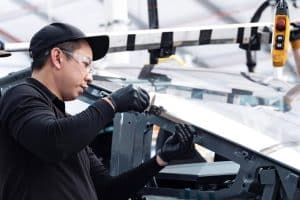The US Postmaster General has blown off the electric vehicle revolution, but the US Army can show him how it’s done. The Army just launched a net zero goal and the Army Reserve already has an electrification plan for its non-tactical vehicles with a zero emission goal by the end of FY 27. That’s partly on account of climate change, and competition from near-peer adversaries also comes into play.
Climate Change & National Defense
The US Department of Defense is well aware that climate change is a leading national security threat, having included climate impacts in its Quadrennial Defense Reports going back to 2010. In 2020, the US Air Force proposed a carbon negative goal across all the Armed Services, and last month the US Army announced a net zero goal.
Not to be confused with the National Guard, the US Army Reserve consists of soldiers who serve part-time and train regularly. Their main mission is to fill Army jobs that are vacated when active duty soldiers get deployed, though if the need is great, the Reserve can be deployed as well.
The US Army Reserve is right on point with the Defense Department’s messaging on climate change. Earlier this month it published an overview of its EV plans, leading with the observation that “climate change and near-peer adversary innovations demand the Army diversify energy sources” and focus on “energy efficiency and resilience.”
The US Army, Near-Peer Adversaries, And…
The pairing of climate change with the emergence of peer and near-peer threats is an interesting one, because it is directly relevant to the US posture towards Russia, which embarked on a murderous, unprovoked rampage through neighboring Ukraine last week.
Army Gen. Martin E. Dempsey set the stage for that attack seven years ago, in a speech at the Danish Army Academy in 2015. The speech was intended to underscore an experience gap in the US armed services. Americans who served during the Cold War had a different experience regarding peer threats, compared to those who came after the breakup of the Soviet Union.
Dempsey noted that signs of a shift in ground came with the 9/11 attack, which exposed US vulnerabilities at home, but the real game-changer came in 2012, when Russia overran and annexed Crimea. Russia literally changed its borders, leveraged ethnic tensions, and undermined credibility of NATO.
“It’s the first time in 41 years we’ve had a legitimate risk emanating from state actors,” Dempsey observed.
Foreshadowing the Russian invasion of Ukraine, Dempsey warned that the US needs to step back into its Cold War mindset and prepare, once again, to face equivalent threats.
Those fighting today need to “understand how to live in that world, understand how to use the military instrument in that world, understand the meaning of deterrence, understand the meaning of maneuver and how to set a theater,” he concluded.
Dempsey’s words rippled out in force just one year later in 2016, when former President Trump won election as a friend of Russia, an enemy of NATO, and an alleged extortionist accused of withholding military aid to Ukraine in exchange for a political favor.
…Tanks, But No Tanks
That brings us around to the US Army and the electric vehicle question. The Army has been slow on the EV uptake. The consensus is that 100% electrification is a long way off for tanks and other tactical vehicles, though fuel efficiency improvements and plug-in hybrids are within sight. Last week the Army unveiled two hybrid electric Bradley tank prototypes, pointing out tactical benefits like silent drive, as well as fuel efficiency and ease of maintenance.
In terms of tank warfare, though, something has to change. The US experience in Iraq demonstrated tactical and logistical shortcomings, and now Russia is providing another demo. Within days after Russia first invaded Ukraine, reports of fuel shortages began to emerge, along with photos and videos of Russian tanks and other vehicles abandoned by the roadside. Military observers have also noted that the soft ground has forced Russian tanks to stay on roads, where they are more vulnerable, and that tanks are ill suited to warfare in urban settings, where Russia has been focusing much of its efforts.
More Electric Vehicles For The US Army
The US Marines Corps saw the writing on the wall several years ago and handed off its tanks to the US Army, which is still committed to tanks. However, the Army is hedging its bets, in the form of the Joint Light Tactical Vehicle program.
The JLTV program is led by the Army, and it will supply the Marines Corps as well. The aim is to develop a new vehicle that can “close an existing capability gap,” which indicates a focus on off-road and urban warfare.
The program involves a 2-seat and a 4-seat version, both of which can be helicoptered into their use points if road or marine travel is less than optimal, reducing the need for long, vulnerable convoys.
“Its maneuverability enables activities across the spectrum of terrain, including urban areas, while providing inherent and supplemental armor against direct fire and improvised explosive device threats,” the Army notes.
To the extent that the JLTV replaces tanks, the potential for the electrification of tactical vehicles suddenly pops into view, and at least one US Defense contractor is already has an eye on that opportunity.
So, What About An Electric JLTV For The US Army?
Last month, Oshkosh Defense debuted its concept for a hybrid electric JLTV, the eJLTV, billed as the “first-ever silent drive hybrid-electric Joint Light Tactical Vehicle.”
“The eJLTV offers the U.S. Army and U.S. Marine Corps the same level of performance and protection as the base JLTV with the addition of silent drive, extended silent watch, enhanced fuel economy, and increased exportable power that enables it to be used in combat and reconnaissance scenarios,” Oshkosh enthused.
Full electrification is going to take a while, but an all-electric JLTV seems more doable than an all-electric tank, especially if fuel cells come into play. In addition, the US Army is edging towards an electrification program for its Light Reconnaissance Vehicles. If you have any thoughts about that, drop us a note in the comment thread.
Meanwhile, the US Army Reserve has launched an EV program for its non-tactical vehicles. The initial phase of the program involves installing 27 Level 2 charging stations with multiple ports at 3 US Army Reserve facilities in Washington and California, along with the delivery of 60 all-electric or plug-in hybrid vehicles.
After FY 23, the pace will pick up sharply.
“The Phase 1 Army Reserve EV pilot program will conclude in FY23. Phase 2 will add 96 vehicles to 9 facilities, Phase 3 will more widely rollout 934 vehicles to 101 facilities, and Phase 4 will add 962 vehicles at the remaining 650 facilities. The future all-electric Army Reserve NTV fleet will include over 2,000 vehicles at 763 total facilities,” the US Army Reserve writes.
There, Was That So Hard?
Against this backdrop, Postmaster General Louis DeJoy’s decision to lock the Postal Service into a massive new purchase plan for gas-powered delivery trucks seems rather dated. After all, lots of other trucks are being electrified, including garbage trucks and fire trucks.
Speaking of electric fire trucks, Oshkosh Defense makes those. The company has also stated that its winning mail delivery truck was purpose-designed for gas or electricity. Between one thing and another, there may be a pathway for electrification in that Postal Service contract after all.
As for Russia, as of this writing, it has not given up on tank warfare. Eventually it may declare some sort of victory, but when the shooting stops, the war crimes trials will begin. Russia’s position and economic status in the world will be crippled for generations to come, just as it was during the Cold War.
Follow me on Twitter @TinaMCasey.
Photo: A prototype hybrid electric tank is part of the US Army’s electric vehicle plans (photo courtesy of US Army).





